As the warm spring weather arrives, farmers in Ohio, Pennsylvania, and West Virginia must also prepare for the onset of severe weather season. While routine tasks like securing barn doors before a storm and checking for damage afterwards are common, the possibility of a natural disaster looms over every farm.
Chuck Glenn’s farm in Chester, West Virginia, experienced the direct impact of an EF-2 tornado on May 8, 2024. This event serves as a stark reminder of the unpredictability of nature and the importance of being prepared for any potential disaster.
In the aftermath of Hurricane Helene and subsequent wildfires in western North Carolina, farmers across the region are facing the reality of multiple catastrophes within a short span of time. The resilience of communities and the need for preparedness are evident, especially for farmers who are not only responsible for themselves but also for the welfare of their livestock.
The significance of preparedness extends beyond individual farms to national food security, public health, economic stability, environmental protection, and community resilience. According to FEMA, livestock preparedness is a critical component of ensuring these essential aspects of society are safeguarded in the face of natural disasters.
Assessing the risks and hazards specific to your farm is the first step in preparing for a natural disaster. Understanding the potential threats such as flooding, severe storms, tornadoes, wildfires, and other emergencies allows farmers to develop tailored plans to mitigate risks and protect their animals and property.
Creating a comprehensive plan for each type of hazard, outlining step-by-step procedures, and identifying evacuation routes and shelter options are essential components of preparedness. Collaboration with farm employees or regular helpers to ensure everyone is familiar with the plan can streamline response efforts during emergencies.
Proactive measures such as trimming trees, clearing debris, and establishing communication with local emergency management agencies contribute to overall preparedness. Additionally, conditioning animals for handling, transportation, and evacuation enhances their safety and reduces stress during crisis situations.
Building a disaster kit for animals, containing essential supplies like handling equipment, identification records, first aid supplies, and emergency tools, helps farmers respond swiftly during evacuations or emergencies. Maintaining a list of items to grab quickly in case of immediate evacuation enables efficient decision-making and resource management.
Community engagement and collaboration are vital aspects of disaster preparedness, especially in rural areas where resources may be limited. Establishing relationships with neighbors, local officials, and community leaders fosters mutual support and cooperation during challenging times.
Resources such as the Iowa State University Center for Food Security and Public Health’s website provide valuable tools and checklists for rural communities to enhance their preparedness for various types of disasters. Leveraging these resources and actively participating in community events and meetings can strengthen resilience and readiness for unforeseen challenges.
Ultimately, proactive preparedness, comprehensive planning, community engagement, and utilization of available resources are key elements in safeguarding farms and livestock against natural disasters. By prioritizing readiness and collaboration, farmers can effectively navigate crises and protect their livelihoods in the face of adversity.




